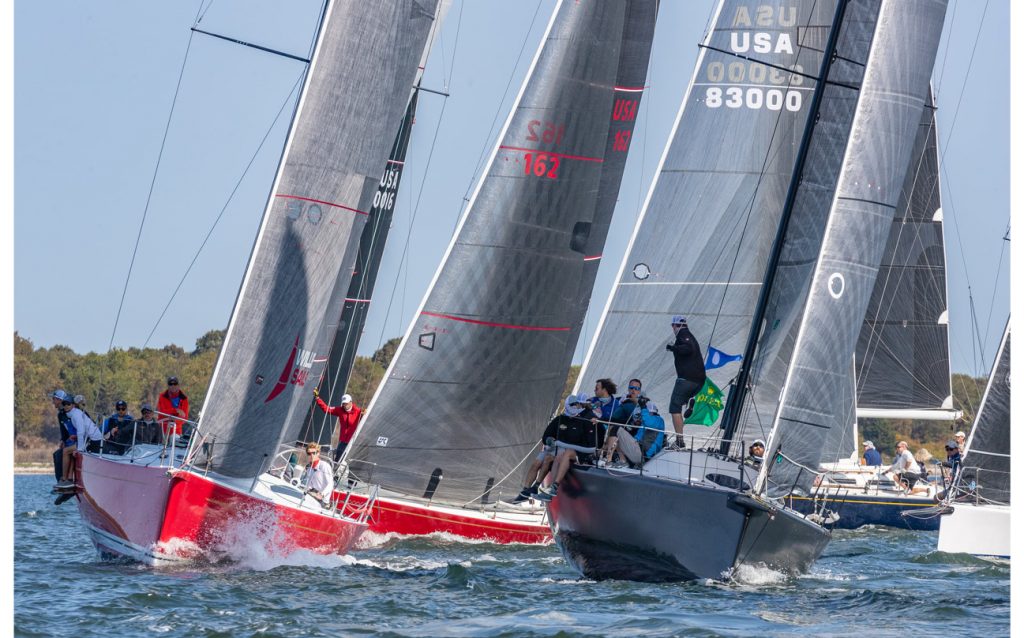If you want to get around the windward mark quickly, you have to know something about laylines. Laylines are those imaginary dotted pathways on the water that show the course a boat would sail to fetch the mark on either tack.
Though laylines are generally good places to avoid, you have to reach one sooner or later in order to round the mark. So it’s important to know where they are. Of course, laylines are never etched in stone. They change all the time based on a number of different factors:
• Tacking angle – The laylines are, first and foremost, a function of your boat’s tacking angle. When you’re sailing a narrow-winded Etchells, for example, you will obviously get to the layline sooner than you will in an Optimist, which tacks through about 90° at best.
• Wind direction – The wind direction is almost always chang- ing, at least a little, and this has a direct impact on the location of your laylines. For example, if the wind direction shifts 10° to the right, then the laylines will move by 10° as well.
• Wind velocity – Since wind pressure affects a boat’s tacking angle, it will also have a significant impact on laylines. In light air your laylines will be wider apart because you can’t point so high. As the breeze builds, they get narrower.
• Waves – The more chop you have, the more you will have to go for footing instead of pointing. This means your tacking angle, and thus your laylines, will be wider.
• Current – When the water is moving, this can affect laylines more than almost any other factor, especially if the wind is light and the current is strong.
• Leeway – One more small influence on laylines is leeway (i.e. the angle between the course you’re steering and your course made good through the water). This is different for every boat and will be greatest (maybe 3° or 4°) in waves and wind.
All these factors make it hard to find the windward mark laylines, especially when you are relatively far away. So, to execute a good layline strategy, keep your head out of the boat.

As you get closer to the windward mark, you often encounter lots of boats and close tactical maneuvers. It’s easy to get caught up in traffic and lose many places. If you want to avoid this and round the mark in good shape, keep your head out of the boat. © New York Yacht Club
How to call the layline
It’s not easy to know exactly when you reach the layline, especially if the windward mark is far away. Here are some techniques to help you figure out when you can tack and fetch the mark.
• “Eyeball” the mark. Many boats have a tacking angle of roughly 80° or 90°, so you’re at the layline when the mark is abeam or slightly forward of abeam.
• Look at the angles of other boats. Watch boats on the opposite tack (especially when you cross behind them near the layline) to see how high they can sail.
• Use “tacking lines” on your deck. If your boat is big enough, put tacking lines on the deck. Figure out your tacking angle and then sight along your tacking lines to identify when you’re on the layline.
• Use a hand-bearing compass. If you have one of these, take note of your average heading on each tack while you’re sailing up the beat. Then use these numbers to identify your layline on the compass. ■
This article originally appeared in David Dellenbaugh’s Speed & Smarts, The newsletter of how-to tips for racing sailors. If you want to sail faster and smarter, log onto SpeedandSmarts.com.
A resident of Easton, CT, Dellenbaugh was tactician and starting helmsman for America3’s successful defense of the America’s Cup in 1992. He’s a Lightning World Champion, two-time Congressional Cup winner, seven-time Thistle National Champion, two-time winner of the Canada’s Cup, three-time Prince of Wales U.S. Match Racing Champion, and a winner of the U.S. Team Racing Championships for the Hinman Trophy.




